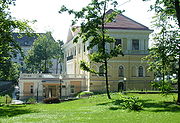
Baworowscy Library
Encyclopedia


Polish language
Polish is a language of the Lechitic subgroup of West Slavic languages, used throughout Poland and by Polish minorities in other countries...
: Biblioteka Baworowskich) was one of major Polish libraries, with thousands of books and historical documents. It was located in Lwow (now Lviv, Ukraine), and ceased to exist after World War II
World War II
World War II, or the Second World War , was a global conflict lasting from 1939 to 1945, involving most of the world's nations—including all of the great powers—eventually forming two opposing military alliances: the Allies and the Axis...
.
History
The library was founded in the mid-19th century, by count Wiktor Baworowski (1826–1894), who was a great admirer of literature, and translator of works of Lord Byron, and Victor HugoVictor Hugo
Victor-Marie Hugo was a Frenchpoet, playwright, novelist, essayist, visual artist, statesman, human rights activist and exponent of the Romantic movement in France....
. Baworowski had a large collection of artworks, and a private library of some 60,000 volumes. He owned his own palace in Lwow, which used to be in former arsenal of the Sieniawski family. The arsenal was built in 1630 by general of artillery Pawel Grodzicki. In the 19th century, it belonged to the Czartoryski family, and later was purchased by the Baworowski family. The new owners redecorated the building, turning it in 1830 into a palace.
The most important part of the library included precious topographical papers, and historic materials in books and manuscripts. In 1944, it had around 38,000 prints, including 30 incunabula
Incunabulum
Incunable, or sometimes incunabulum is a book, pamphlet, or broadside, that was printed — not handwritten — before the year 1501 in Europe...
, and 1254 manuscripts. There also was the gallery of 285 oil paintings, and 11 000 sketches. The collection included some of the most precious documents of the early history of Poland (Chronicle of Wincenty Kadlubek
Wincenty Kadlubek
Blessed Wincenty Kadłubek , also known as Vincent Kadlubek, Vincent Kadlubo, Vincent Kadlubko, Vincent of Kraków, Master Vincentius, was a thirteenth century Bishop of Cracow and historian of Poland.-Biography:...
, and Statutes of Kazimierz Wielki), as well as letters and autographs of Julian Ursyn Niemcewicz
Julian Ursyn Niemcewicz
Julian Ursyn Niemcewicz was a Polish poet, playwright and statesman. He was a leading advocate for the Constitution of May 3, 1791.-Life:...
, Jan Sniadeck, Aleksander Fredro
Aleksander Fredro
Aleksander Fredro was a Polish poet, playwright and author.-Life:Count Aleksander Fredro, of the Bończa coat of arms, was born in the village of Surochów near Jarosław, then a crown territory of Austria. A landowner's son, he was educated at home. He entered the Polish army at age 16 and saw...
, and Stanislaw Konarski
Stanislaw Konarski
Stanisław Konarski was a Polish pedagogue, educational reformer, political writer, poet, dramatist, Piarist monk and precursor of the Polish Enlightenment.Konarski studied 1725-27 at the Collegium Nazarenum in Rome, where he became a...
.
Across the years, the Baworowscy Library was expanded by collections from other libraries. Altogether, 15,000 prints and 10,000 drawings were added, including:
- a collection of 7,000 volumes of count Zygmunt Czarnecki. These were rare papers connected with early Polish history and law, but also religious documents of Dioceses of Krakow and Poznan.
- a collection of some 8,000 volumes of the World War IWorld War IWorld War I , which was predominantly called the World War or the Great War from its occurrence until 1939, and the First World War or World War I thereafter, was a major war centred in Europe that began on 28 July 1914 and lasted until 11 November 1918...
period, including all prints of the Supreme National CommitteeSupreme National CommitteeNaczelny Komitet Narodowy was a quasi-government for the Poles in Galicia, Austro-Hungarian Empire, from 1914-1917...
The library also included several pieces of precious furniture from the 17th and 18th centuries, old weaponry, china, clocks, coins, and medals. Art gallery of the library included 300 works of Polish, Dutch, German and Italian painters, such as Mengs, Dolci, Renie, Domenichin, Canaletto, Juliusz Kossak
Juliusz Kossak
Juliusz Fortunat Kossak was a Polish historical painter and master illustrator who specialized in battle scenes, military portraits and horses...
.
After Soviet invasion of eastern Poland, the library was managed by Rudolf Kotula, who on April 13, 1940, together with thousands of Poles, was forcibly taken to Siberia
Siberia
Siberia is an extensive region constituting almost all of Northern Asia. Comprising the central and eastern portion of the Russian Federation, it was part of the Soviet Union from its beginning, as its predecessor states, the Tsardom of Russia and the Russian Empire, conquered it during the 16th...
. Kotula was replaced by Stefan Inglot
Stefan Inglot
Stefan Inglot was a Polish historian and a cooperative activist.Stefan was professor on the Lwów University since 1939...
of the Ossolineum
Ossolineum
The Ossolineum or Zakład Narodowy im. Ossolińskich a meritorious department for Polish science and culture , which was founded for the Polish Nation in 1817 by Józef Maksymilian Ossoliński, and was opened in 1827 in Lviv.It was one of the most important Polish...
. The collection was gradually scattered among Soviet-created institutions. Between 1941 and 1944, under German occupation, the library was reopened under management of professor Mieczyslaw Gebarowicz, who in early 1944, as the Red Army
Red Army
The Workers' and Peasants' Red Army started out as the Soviet Union's revolutionary communist combat groups during the Russian Civil War of 1918-1922. It grew into the national army of the Soviet Union. By the 1930s the Red Army was among the largest armies in history.The "Red Army" name refers to...
advanced westwards, transferred some of the works of art to the National Library in Krakow.

